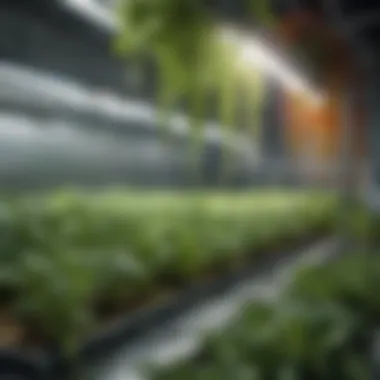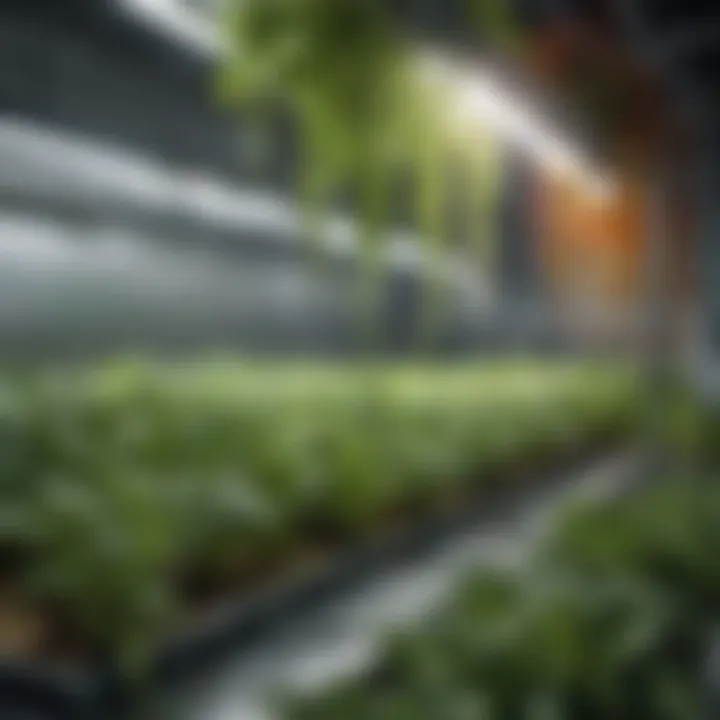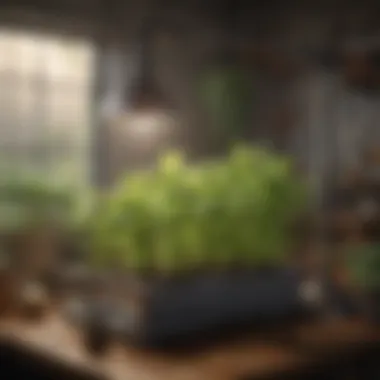Exploring Hydroponic Garden Stands for Sustainable Gardening


Intro
Hydroponic gardening is an innovative approach to growing plants without soil. This method relies on nutrient-rich water solutions to nourish plants while minimizing the need for traditional agricultural practices. As the world searches for sustainable solutions, hydroponics presents an appealing alternative. Hydroponic garden stands are integral to this practice, offering versatile options for both beginners and experienced gardeners. Understanding their functionality and benefits can significantly enhance your gardening experience and contribute to moving towards sustainable agricultural practices.
Overview of the Topic
Definition and Importance
Hydroponic garden stands are structures designed to support plants in a soil-free environment. They facilitate the growth of plants by providing a stable framework where the roots can access nutrient-rich water. This method is essential as it uses significantly less water compared to traditional farming methods while delivering faster plant growth and higher yields.
Current Trends
The trend towards urban gardening has accelerated interest in hydroponic systems. More individuals live in urban settings lacking adequate space for traditional gardens. As a result, hydroponic garden stands have become popular, catering to this demographic. Many people now seek to cultivate their own food regardless of space constraints, thus driving innovation in hydroponic gardening designs. Moreover, the focus on environmentally-friendly practices contributes to the rising popularity of these garden stands.
Key Techniques and Practices
Step-by-Step Guide
Creating a successful hydroponic setup involves several essential steps:
- Select a Location: Choose a spot with ample sunlight or a suitable artificial light source.
- Choose Your Hydroponic System: Options include nutrient film technique (NFT), deep water culture (DWC), and aeroponics depending on the space and plants selected.
- Set Up the Garden Stand: Position the hydroponic stand securely, ensuring it can support the weight of both plants and water.
- Mix Nutrient Solutions: Prepare the nutrient-rich water following the manufacturer’s guidelines.
- Plant Your Seeds: Place seeds or seedlings into the system, ensuring they are snugly fit to the support medium.
- Monitor and Adjust: Keep track of pH levels, nutrient concentration, and overall plant health.
Tools and Equipment Needed
To embark on your hydroponic journey, you will need:
- Hydroponic garden stand
- Water pump
- Nutrients specifically designed for hydroponics
- pH meter
- Light source (if natural light is insufficient)
- Growing medium such as rock wool or clay pebbles
Challenges and Solutions
Common Obstacles
Hydroponic gardening comes with challenges.
- Disease Management: Without soil, plant diseases can spread quickly if not monitored.
- Nutrient Imbalance: Over or under-fertilizing can harm plants.
Innovative Solutions
Adopting proactive measures can alleviate these issues effectively.
- Regularly check for pests and diseases, promptly removing affected plants.
- Utilize hydroponic nutrient solutions specifically designed to suit your plants' needs, adjusting as growth stages change.
"By understanding the requirements of each plant type, gardeners can achieve significant yields in tight spaces, making hydroponic stands a vital part of modern gardening."
Epilogue
Hydroponic garden stands represent a significant advancement in sustainable gardening practices. Their design and functionality are tailored for efficient plant growth, crucial for today's urban landscapes. By familiarizing oneself with the tools, techniques, and challenges associated with hydroponic gardening, farmers and enthusiasts can contribute to a more sustainable agricultural future.
Understanding Hydroponics
Understanding hydroponics lays the foundation for appreciating how garden stands enhance sustainable gardening practices. This method of growing plants without soil relies on nutrient-rich water solutions, and the versatility of hydroponics allows for diverse settings. From urban environments to modern farms, hydroponics can make efficient use of limited space, helping achieve the growing food demands of our global population.
Benefits of Hydroponics:
- Water Efficiency: Hydroponic systems utilize about 90% less water than traditional soil gardening. This efficiency is crucial in regions where water scarcity is a concern.
- Space Optimization: Growers can cultivate more plants in less space. Structures such as vertical garden stands maximize available area.
- Pest and Disease Control: Soilless gardening reduces the risks associated with pests and soil-borne diseases.
Moreover, hydroponics allows for year-round cultivation. This is particularly relevant for those in regions with extreme weather patterns. Consequently, gardeners can enjoy fresh produce regardless of the season, which is beneficial for both the consumer and local economies.
What is Hydroponics?
Hydroponics is a method of growing plants using water instead of soil. In hydroponic systems, plants are placed in a nutrient solution that provides all the essential nutrients for growth. The roots of the plants are submerged or misted with the solution, which ensures they receive the nutrients efficiently while also having access to oxygen. This setup accelerates growth rates and can lead to higher yields compared to traditional methods.
The key to successful hydroponics is understanding the balance of nutrients. Different plants require different nutrient profiles, necessitating careful monitoring and adjustments. With proper management, hydroponics can produce healthy vegetables, herbs, and flowers.
History of Hydroponic Systems
Hydroponics is not a recent invention; its roots date back centuries. The earliest documented instances of soilless cultivation can be traced to the Hanging Gardens of Babylon. While these gardens might be more mythical than factual, they indicate an early understanding of plant growth outside traditional soil.
In the 17th century, scientists began to experiment with hydroponic principles. Notable figures like Francis Beaumont and later, Nikola Tesla, conducted studies that contributed to the understanding of plant growth in controlled environments. The modern form of hydroponics, known as nutrient film technique, emerged in the 20th century, paving the way for today's advanced systems.


The rise of hydroponics gained momentum particularly during the food crises of the 20th century. Innovations in agricultural technology and sustainable practices have transformed hydroponics into a viable solution to global food security challenges. It remains an area of ongoing research and development.
The Concept of Garden Stands in Hydroponics
The integration of garden stands into hydroponic systems signifies a transition toward more efficient and versatile methods of planting. Understanding this concept is essential for both the novice and the experienced gardener. The ability to utilize vertical space, enhance light exposure, and facilitate watering and nutrient distribution has made garden stands a critical component in achieving successful hydroponic growth. This section delves into the specifics of what constitutes a garden stand and its pivotal role in hydroponic gardening.
Definition of Garden Stands
Garden stands refer to the structures designed to support hydroponic systems, providing a framework for growing plants without soil. They can vary in design, size, and functionality. Some stands may be simple frames that hold containers, while others could be intricate systems featuring multiple layers for optimal plant placement. The essential characteristic of a garden stand is its ability to create an organized space for plant growth, allowing easy access for maintenance and observation.
Role of Stands in Hydroponic Gardening
Garden stands play a crucial role in enhancing the efficiency of hydroponic gardening. Here are key aspects of their function:
- Space Optimization: Garden stands maximize available space, particularly in indoor or small outdoor settings. By elevating plants vertically, these stands enable gardeners to grow more produce without requiring additional ground space.
- Light Accessibility: These stands often allow for better light penetration. By spacing plants evenly and ensuring none are shaded by others, all plants can receive adequate light for photosynthesis. This is important in hydroponics where artificial lighting may supplement natural sources.
- Water Drainage: Effective drainage systems integrated into the garden stands help prevent waterlogging, which can be detrimental to plant roots. Proper drainage also promotes healthy root growth and nutrient absorption.
- Ease of Maintenance: Garden stands simplify the process of inspecting and caring for plants. With an organized layout, growers can easily monitor plant health and perform necessary tasks such as trimming and replanting.
"Well-designed garden stands can lead to significantly improved plant yields and easier maintenance for the gardener."
In summary, garden stands represent a multifaceted tool in hydroponic gardening, contributing to space efficiency, light access, and ease of maintenance, while ensuring that plants thrive in a controlled environment. Understanding their definition and role is foundational for anyone looking to delve deeper into hydroponics.
Types of Hydroponic Garden Stands
The variety of hydroponic garden stands plays an important role in enhancing sustainable gardening practices. Each type serves unique purposes and accommodates different gardening needs and spaces. By understanding these diverse stands, one can optimize plant growth and maximize limited space. It also allows gardeners to select a stand that aligns with their available resources and project goals, making it critical to this article.
Vertical Hydroponic Garden Stands
Vertical hydroponic garden stands utilize vertical space to grow plants. This design is particularly effective in urban areas or small gardens where ground space is limited. Building upwards allows for more plants to be grown in a smaller footprint. An essential advantage is the improved air circulation and light exposure since plants receive sunlight or artificial light from multiple angles. This method also reduces the likelihood of pests and diseases compared to traditional beds.
Common materials for vertical stands include PVC pipes, shelving units, or specially designed vertical planters. Integrating a drip system can further enhance efficiency by ensuring that every plant receives adequate water and nutrients.
Ultimately, vertical stands are favored for their space-saving qualities and capability to maximize yield without requiring extensive land.
Tabletop Hydroponic Systems
Tabletop hydroponic systems are compact and designed for limited space. They sit on tables or counters, making them suitable for homes, classrooms, or small offices. This design is especially appealing for beginners, as they can be easily monitored and maintained.
These systems typically consist of a shallow reservoir with plants growing above water, utilizing a nutrient-rich solution. Some popular configurations include Kratky or nutrient film technique setups. They can grow a variety of plants, from herbs to small leafy greens. Their accessibility makes it easy for gardeners to tend to the plants and control environmental factors such as light and temperature.
However, one should consider the weight of the tabletop system once filled. Structural integrity is vital to prevent any accidents or damage. With careful planning, tabletop stands can effectively contribute to sustainable gardening practices while also being decorative.
Mobile and Adjustable Stands
Mobile and adjustable stands provide flexibility, allowing gardeners to reposition their plants according to changing light conditions or seasonal weather. These stands often feature wheels or a movable design, making them easy to shift indoor and outdoor. For hydroponic setups, this adaptability ensures optimal light exposure and temperature control.
The adjustable height feature supports different plant types, accommodating both short and tall crops as they grow. This versatility is particularly important for gardeners who cultivate multiple species or have varying preferences for plant treatment.
While mobile and adjustable stands can be more expensive due to their complexity, the long-term benefits include improved yield and plant health. Careful consideration of material selection is necessary to balance durability with mobility.
Design and Construction of Hydroponic Garden Stands
The design and construction of hydroponic garden stands are crucial aspects of effective hydroponic gardening. A well-constructed stand enhances the overall functionality, aesthetics, and sustainability of the garden. The materials selected and the thought process behind the design significantly influence not only the operational success of the system but also the long-term health of the plants. When done correctly, these elements contribute to optimal growth conditions while minimizing resource waste.
Materials Used in Construction
Choosing the right materials is essential for the longevity and efficiency of hydroponic garden stands. Common materials include PVC, wood, and metal.
- PVC is popular due to its lightweight, durability, and resistance to rot. It's easy to assemble and disassemble, making it ideal for indoor or outdoor use.
- Wood offers natural aesthetic and strength but requires treatment to withstand moisture and prevent decay. It is often preferred in environments where aesthetics matter more.
- Metal, while sturdy, can be heavy and prone to rust if not treated properly, making it less suitable for outdoor gardens without protective coatings.
Each material presents unique benefits and limitations that must be weighed against the specific gardening goals of the user.
Design Considerations
When designing a hydroponic garden stand, several factors must be carefully evaluated to ensure maximum efficiency and efficacy.
Space Efficiency
Space efficiency is vital for any hydroponic setup, particularly in urban environments where space may be limited. The stand should allow for vertical stacking of plants, which enables more plants in a smaller footprint.
- A well-designed vertical structure enables optimal light exposure for each plant.
- It is a popular choice as it utilizes every available inch, especially useful in confined spaces.
- However, crossing a fine line is often required; too many plants crammed together can lead to over-competition for nutrients and insufficient light.
Light Accessibility


Light accessibility refers to the ability of plants to receive the right amount of light for photosynthesis. Plants require adequate lighting for healthy growth, and improper designs can hinder this.
- An effective design allows light to reach all plants evenly, which is essential for uniform growth.
- This characteristic is beneficial as it encourages faster growth and healthier plants.
- Designing with adjustable shelves can solve shading issues, allowing users to fit different plant sizes into their system.
Water Drainage
Water drainage is an often-overlooked aspect of designing hydroponic stands. Good drainage ensures that excess water does not accumulate, which could lead to root rot.
- A well-thought-out drainage system allows water to flow out and prevents waterlogging, which can harm plant roots.
- This feature is essential as it helps maintain healthy root structures.
- Implementing slanted surfaces or drainage holes enhances efficiency by facilitating proper water movement.
"Well-designed hydroponic systems yield more than just plants; they offer sustainable food solutions for our growing populations."
To learn more about different types of hydroponic methods, you can explore resources on platforms like Wikipedia, Britannica, or engage in discussions on Reddit.
Setting Up Your Hydroponic Garden Stand
Setting up a hydroponic garden stand is an essential phase in achieving a productive and efficient gardening system. It involves careful consideration of various factors that can influence the success of your gardening venture. The right setup can enhance plant growth, increase yields, and improve the overall gardening experience. In this section, we will discuss the key aspects of setting up your hydroponic garden stand, focusing on location selection, assembly, and nutrient integration.
Choosing the Right Location
Choosing a suitable location for your hydroponic garden stand cannot be overstated. The location affects light accessibility, temperature control, and water drainage. Look for an area that receives ample natural light or one that can accommodate grow lights effectively. Furthermore, ensure the space has good air circulation to prevent heat buildup and moisture accumulation.
It is also wise to avoid areas where plants are subject to extreme temperature fluctuations or drafts. This will help in maintaining consistent growth conditions. Ultimately, a well-thought-out location can significantly contribute to the vitality of your plants and ease of maintenance.
Assembling the Stand
Assembling the stand properly is vital to ensuring stability and functionality. A sound structure can support the weight of the plants and the equipment needed for hydroponics. A robust assembly process involves the following steps:
Step-by-Step Assembly
The step-by-step assembly of the hydroponic stand involves clear, systematic instructions for fitting parts together. Typically, you should start by laying out all the components to verify that nothing is missing. Use assembly guides to attach the base and vertical supports securely. This clarity in assembly allows even novice gardeners to create a firm structure with confidence.
One unique feature of this method is its adaptability; instructions can often be customized to fit space or design preferences. However, improper assembly can lead to instability, which could risk the entire setup.
Testing Stability
Once the stand is assembled, it is crucial to conduct a testing stability check. This ensures that the structure can withstand the weight of your garden and remain upright under various conditions. Gently applying pressure can help identify any weaknesses in joints or attachments.
The key characteristic of this process is its proactive nature. By addressing stability early on, you can prevent future problems that might arise from an unstable setup. One advantage of thorough testing is that it fosters a sense of security. Yet, one must be cautious not to overestimate stability based on an initial test, as ongoing maintenance is essential.
Integrating Nutrient Solutions
Integrating nutrient solutions into your hydroponic garden stand is a crucial element of the setup process. The nutrients provide essential elements for plant growth, so understanding how to incorporate them effectively will yield better results.
Begin by selecting the appropriate nutrient solution tailored to the specific plants you are cultivating. Carefully follow the mixing instructions to ensure you achieve the right concentration. This aspect helps prevent nutrient burn or deficiencies.
Placement of the nutrient system should allow for easy monitoring and refilling. Setting up a reservoir that is easy to access will highly streamline maintenance tasks. Regular assessments and adjustments of the nutrient levels are necessary to reflect the plants' growth stages and their changing needs. This ongoing integration leads to healthier plants and optimal harvests.
Maintenance of Hydroponic Garden Stands
Maintaining hydroponic garden stands is critical to ensuring optimal growing conditions for plants. Regular upkeep directly affects plant health, growth rates, and overall yield. With the absence of soil in hydroponics, each element in the system plays a crucial role. This section outlines essential maintenance tasks to keep your garden stand functional and productive.
Regular Cleaning and Sanitization
Periodic cleaning of hydroponic systems cannot be overstated. Algae, biofilm, and pathogens can accumulate due to moisture and organic materials. These contaminants can lead to reduced plant health and yield. A suitable cleaning routine should include:
- Daily checks: Inspect components for visible residues or contamination.
- Weekly cleaning: Use mild, non-toxic cleaners and rinse thoroughly to avoid chemical residues.
- Sanitization: Use a bleach solution or hydrogen peroxide to sanitize all equipment and surfaces. Ensure that the solution is diluted properly to avoid harming plants.
Regular cleaning not only prevents infections but also promotes a healthy growing environment, ensuring plants receive adequate oxygen and nutrients.
Monitoring Plant Health
Monitoring plant health is a key aspect of hydroponic gardening which should not be overlooked. This involves observing plants for signs of nutritional deficiencies or disease. Effective monitoring includes:
- Visual inspections: Check the leaves for discoloration, spots, or wilting. These could indicate nutrient imbalances or pest issues.
- Growth tracking: Keep records of growth rates and overall plant vigor. This helps in identifying patterns that may require adjustments to the setup.
- Environmental factors: Pay attention to light, temperature, and humidity levels. Imbalances might affect plant health and growth performance.
Adjusting Nutrients and pH Levels
Hydroponic systems rely on nutrient solutions to supply essential minerals. Regularly adjusting these solutions is essential, as plants consume nutrients at different rates. Key actions include:


- Nutrient checks: Use a TDS meter to monitor nutrient concentration. Adjust as necessary based on plant growth stages.
- pH monitoring: Maintaining the correct pH range (typically between 5.5 to 6.5) is crucial. Use pH testing kits or probes to ensure levels are stable. If outside the optimal range, use pH up or pH down solutions to adjust.
- Water quality: Ensure that water used in the system is free from contaminants that can affect nutrient absorption.
By prioritizing maintenance tasks, gardeners can enhance both the efficiency and sustainability of their hydroponic systems. Keeping the garden stand clean, monitoring plant health, and adjusting nutrients will foster an environment conducive to vibrant plant growth.
Challenges in Hydroponic Gardening with Stands
Hydroponic gardening with stands presents unique challenges that both novice and experienced gardeners must navigate. These challenges stem from the intricate balance required in hydroponic systems, where plants grow without soil. Understanding these issues is crucial for creating a thriving garden environment. Addressing them effectively can lead to successful crop yields and a satisfaction that comes from mastering a sustainable form of gardening.
The following subsections will delve into common problems encountered in hydroponic stands and the practical solutions that can mitigate these issues.
Common Problems Encountered
Several problems can arise when using hydroponic garden stands. These include:
- Nutrient Imbalance: Achieving the right nutrient levels is essential for plant health. Too much or too little of certain nutrients can lead to poor plant growth and health.
- pH Fluctuations: Hydroponic systems require a stable pH range for optimal nutrient absorption. Frequent fluctuations can stress plants and hinder growth.
- Water Quality: The quality of water used is critical. Contaminants or improper mineral content can cause significant harm to plants.
- Pest and Disease Management: Just like traditional gardening, hydroponic systems can also fall prey to pests and diseases.
- Structural Stability: The design of stands must support the plants adequately. If not planned carefully, the stands can collapse or become unstable with growing plants.
These issues can lead to decreased yields and potentially frustrating experiences for gardeners.
Solutions to Common Challenges
To overcome the aforementioned challenges, several solutions can be applied:
- Regular Monitoring: Keeping a close eye on nutrient levels and pH can help gardeners make quick adjustments as necessary. Regular testing kits for pH and nutrient levels can be beneficial.
- Use Quality Water: Ensuring the water used is filtered and free from contaminants will contribute positively to plant health.
- Implement Integrated Pest Management (IPM): This strategy combines multiple approaches to control pests, such as using beneficial insects and organic sprays, minimizing chemical usage.
- Choose the Right Materials for Stands: Selecting materials that offer stability and durability will help maintain the integrity of the structure.
- Routine Maintenance and Checks: Scheduled inspections of the system and its components are vital. This includes cleaning the equipment to prevent the buildup of algae or other harmful substances.
Utilizing these solutions can foster a productive environment for hydroponic gardening, allowing gardeners to enjoy the benefits of a sustainable gardening method.
Future of Hydroponic Garden Stands
The potential of hydroponic garden stands is continuously evolving. This section highlights the future possibilities within this field, which is crucial for enhancing sustainable gardening practices. As urbanization increases and traditional farming faces multiple challenges, hydroponic gardening presents viable solutions. Garden stands play a significant role in this ecosystem, offering both functionality and adaptability. The integration of advanced technologies and sustainable practices will shape how we utilize garden stands in the coming years.
Innovations in Design and Technology
Hydroponic garden stands are seeing innovations in their design and technology that are revolutionizing the gardening landscape. New materials, like lightweight composites and recycled plastics, are making stands more durable and eco-friendly. Furthermore, the emergence of smart technology is enhancing garden management. Sensors can monitor nutrient levels, light exposure, and even plant health, providing real-time data to gardeners.
- Modular designs allow for easy customization and scalability. This means gardeners can expand their setup as their needs grow.
- Automated systems can manage watering and nutrient delivery with precision. This reduces labor and optimizes plant growth.
- Vertical integration is becoming a trend, allowing more plants to be grown in limited spaces. This is particularly beneficial in urban settings where space is a constraint.
The impact of these innovations on hydroponics is substantial. They enable more efficient use of resources, thereby minimizing waste and maximizing yield.
Sustainability and Hydroponics
Sustainability is a cornerstone of hydroponic gardening. As society becomes increasingly aware of environmental issues, sustainable practices in gardening gain importance. Hydroponic systems contribute to this by significantly reducing water usage compared to traditional farming methods.
- Reduced water footprint: Hydroponics can use up to 90% less water, as it recirculates nutrients effectively.
- Minimal reliance on pesticides: By maintaining a controlled environment, there is less need for chemical interventions.
With innovations, the emphasis on sustainability will only grow. More gardeners will adopt hydroponic systems, driven by the desire to produce food locally while preserving the environment.
"The future of hydroponic garden stands hinges on technological innovation and sustainability, propelling the gardening community toward more efficient and eco-conscious practices."
As hydroponic garden stands evolve, they embody the shift toward a more sustainable approach in agriculture, crucial for addressing the challenges ahead.
Epilogue
In summarizing the exploration of hydroponic garden stands, it is crucial to emphasize their multifaceted benefits and the sustainability they bring to modern gardening practices. Hydroponics, as a method, eliminates the need for soil and allows for a more resource-efficient form of agriculture. Garden stands serve as a pivotal component by supporting plant growth in a vertical or organized manner, optimizing space and light exposure. They facilitate easier access to plants for maintenance and harvesting, enhancing overall efficiency in care. Given the space constraints in urban settings, these systems can yield numerous crops in a compact area, which is essential for anyone looking to maintain a productive garden.
Highlights of the discussion include:
- The various types of hydroponic stands and their specific uses.
- Detailed insights into the material and design considerations for optimal functionality.
- Important maintenance tips to ensure the longevity and productivity of the hydroponic systems.
Investing time in understanding hydroponic garden stands translates directly into improved gardening results and sustainable practices that cater to the increasing demands of food production.
Overall, incorporating hydroponic systems into gardening not only promotes strong plant growth but also aligns with eco-friendly mindset. As gardening enthusiasts and farmers explore innovative solutions, the importance of adapting such practices cannot be overstated.
Recap of Key Points
To summarize, this article has covered several critical areas regarding hydroponic garden stands, including:
- Definition and Importance: A clear understanding of what hydroponic garden stands are and their role in sustainable gardening.
- Types of Stands: An overview of different stand types like vertical and mobile systems.
- Design Aspects: Key design considerations such as space efficiency and light accessibility.
- Setup and Maintenance: Essential steps in setting up the system and routine care to ensure plant health.
- Future Innovations: How advancements in technology can revolutionize this gardening method.
Each of these elements works together to aid both novice and experienced gardeners in cultivating healthier plants in a sustainable manner.
Encouragement for Future Exploration
The journey into hydroponic gardening is vast and offers numerous opportunities for improving agricultural practices. As technology continues to evolve, so will the designs and functionality of hydroponic systems. Those interested should consider experimenting with different setups or even developing customized stands tailored to specific needs.
Engagement within communities, whether online through platforms like reddit.com or offline through local garden clubs, can also create a support network for learning and sharing experiences.
Staying informed about innovations in hydroponics can lead to discovering new methods, which can improve yield and reduce resource consumption. Future exploration into integrating smart technology into hydroponic gardening could further enhance the experience while promoting environmental sustainability. With profound attention to these developments, gardeners can contribute meaningfully to a more sustainable future.



